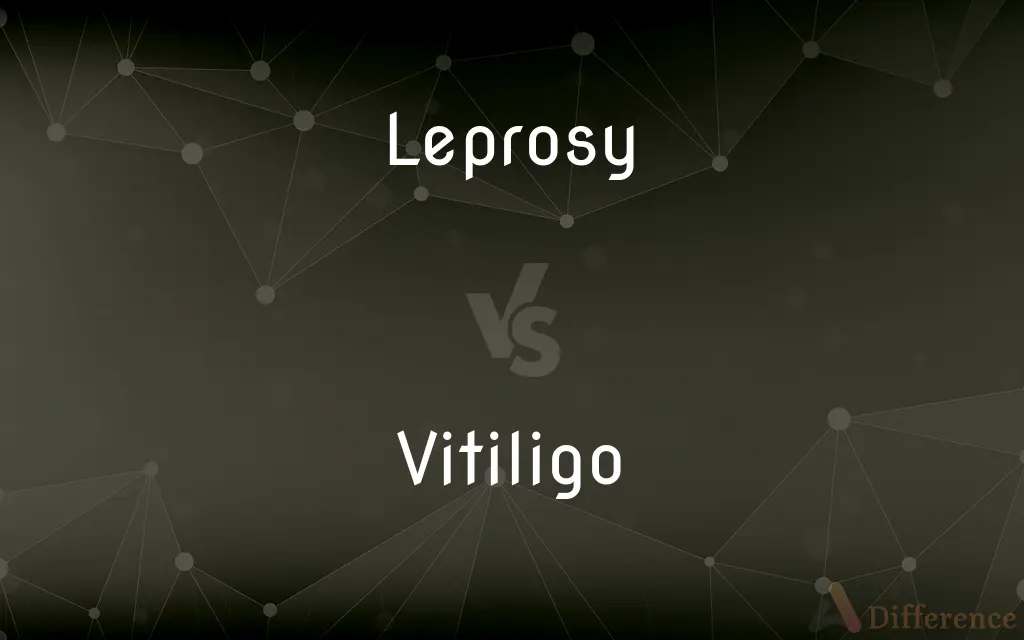Leprosy vs. Vitiligo — What's the Difference?
By Tayyaba Rehman & Maham Liaqat — Updated on March 26, 2024
Leprosy is a chronic infectious disease caused by Mycobacterium leprae, affecting nerves and skin. Vitiligo, however, is an autoimmune condition resulting in the loss of skin pigment, creating patches of lighter skin, without direct physical disability.

Difference Between Leprosy and Vitiligo
Table of Contents
ADVERTISEMENT
Key Differences
Leprosy, also known as Hansen's disease, is primarily caused by the bacteria Mycobacterium leprae, leading to symptoms like skin lesions, nerve damage, and muscle weakness, which can progress to severe disfigurement and disabilities if untreated. Whereas vitiligo is characterized by the immune system attacking and destroying the melanocytes, the cells responsible for producing skin pigment, resulting in white patches on the skin. While leprosy involves a bacterial infection, vitiligo is an autoimmune condition, reflecting a fundamental difference in their etiology.
The transmission of leprosy occurs through prolonged close contact with an untreated infected person, making it a communicable disease. On the other hand, vitiligo is not contagious; its exact cause is unknown but is thought to involve genetic and environmental factors. This distinction is crucial for understanding the spread and management of both conditions.
Treatment approaches for leprosy include a combination of antibiotics to kill the bacteria, often taken for many months to ensure the disease is fully eradicated. In contrast, treatment options for vitiligo may include topical creams to restore skin color, light therapy, and in some cases, surgical options, aiming not to cure but to improve the appearance of the skin. The goals and strategies of treatment differ significantly between the two diseases.
Social and psychological impacts of both conditions can be profound but differ in nature. Leprosy can lead to social stigma and isolation due to its visible symptoms and historical misconceptions, potentially resulting in mental health issues. Vitiligo, while not physically disabling, can also cause significant psychological stress and social stigma, primarily due to cosmetic concerns and the visible contrast in skin color.
Leprosy and vitiligo both result in skin changes, but the presence of nerve damage in leprosy is a critical distinction, leading to loss of sensation and potentially to injuries and disabilities. Vitiligo, however, does not affect the structure or sensation of the skin but changes its color, highlighting a key difference in their physical manifestations.
ADVERTISEMENT
Comparison Chart
Cause
Bacterial infection (Mycobacterium leprae)
Autoimmune condition
Symptoms
Skin lesions, nerve damage, muscle weakness
White patches on the skin
Contagiousness
Yes, through prolonged close contact
No
Treatment
Antibiotics for many months
Topical creams, light therapy, surgical options
Physical Disabilities
Can lead to severe disfigurement and disabilities
Does not directly cause physical disabilities
Psychological Impact
Social stigma, isolation, mental health issues
Psychological stress, social stigma due to appearance
Sensation Affect
Loss of sensation due to nerve damage
Normal skin sensation
Management Goals
Eradicate bacteria, prevent transmission
Improve skin appearance, manage symptoms
Compare with Definitions
Leprosy
Leprosy can lead to muscle weakness and loss of sensation.
Patients with leprosy may not feel injuries due to nerve damage.
Vitiligo
Vitiligo is an autoimmune condition where skin loses its pigment cells.
Vitiligo can affect any area of the skin, leading to white patches.
Leprosy
It is caused by the bacterium Mycobacterium leprae.
Antibiotics are effective against Mycobacterium leprae in leprosy treatment.
Vitiligo
Treatments aim to restore skin color or even out skin tone.
Light therapy is a common treatment for vitiligo.
Leprosy
This disease is transmissible through prolonged close contact.
Leprosy spreads less easily than commonly thought.
Vitiligo
Psychological impact includes stress and stigma about appearance.
Support groups can help those with vitiligo cope with social challenges.
Leprosy
Treatment includes a long-term antibiotic regimen.
Multi-drug therapy is the standard treatment for leprosy.
Vitiligo
It results from the immune system attacking melanocytes.
In vitiligo, the body's defense system mistakenly targets pigment cells.
Leprosy
Leprosy is a chronic infectious disease that primarily affects the skin and nerves.
Early detection of leprosy can prevent nerve damage.
Vitiligo
Vitiligo is not contagious or life-threatening.
Vitiligo affects individuals' skin appearance but is not medically dangerous.
Leprosy
Leprosy, also known as Hansen's disease (HD), is a long-term infection by the bacteria Mycobacterium leprae or Mycobacterium lepromatosis. Infection can lead to damage of the nerves, respiratory tract, skin, and eyes.
Vitiligo
Vitiligo is a long-term skin condition characterized by patches of the skin losing their pigment. The patches of skin affected become white and usually have sharp margins.
Leprosy
A chronic, mildly contagious disease of tropical and subtropical regions, caused by the bacterium Mycobacterium leprae, marked by lesions of the skin and mucous membranes and damage to peripheral nerves and other organs that, if untreated, can progress to disfigurement, lack of sensation, and blindness. Also called Hansen's disease.
Vitiligo
A condition in which the pigment is lost from areas of the skin, causing whitish patches, often with no clear cause.
Leprosy
(medicine) An infectious disease caused by the bacterium Mycobacterium leprae, gradually producing nerve damage and patches of skin necrosis and historically handled by permanently quarantining its sufferers.
Leprosy seems to have spread from India to the Middle East by early antiquity and from there to Europe during the time of the Roman Empire.
Vitiligo
Partial or total loss of skin pigmentation, often occurring in patches.
Leprosy
Similar contagious skin diseases causing light patches of scaly skin, particularly psoriasis, syphilis, vitiligo, scabies, and (biblical) the various diseases considered "tzaraath" in the Old Testament of the Bible.
Vitiligo
(dermatology) The patchy loss of skin pigmentation.
Leprosy
(figurative) Anything considered similarly permanent, harmful, and communicable, particularly when such a thing should be handled by avoidance or isolation of its victims.
Sin is a spiritual leprosy.
Vitiligo
(obsolete) Alphos, a form of leprosy.
Leprosy
(veterenary medicine) A contagious disease causing similar effects in animals, particularly
Vitiligo
A rare skin disease consisting in the development of smooth, milk-white spots upon various parts of the body.
Leprosy
Ellipsis of murine leprosy}} and {{en, diseases caused in rodents and cats by Mycobacterium lepraemurium.
Vitiligo
An acquired skin disease characterized by patches of unpigmented skin (often surrounded by a heavily pigmented border)
Leprosy
(obsolete) mange and {{en}} in horses.
Leprosy
Synonym of leprosarium: a place for the housing of lepers in isolation from the rest of society.
Leprosy
A cutaneous disease which first appears as blebs or as reddish, shining, slightly prominent spots, with spreading edges. These are often followed by an eruption of dark or yellowish prominent nodules, frequently producing great deformity. In one variety of the disease, anæsthesia of the skin is a prominent symptom. In addition there may be wasting of the muscles, falling out of the hair and nails, and distortion of the hands and feet with destruction of the bones and joints. It is incurable, and is probably contagious.
Leprosy
Chronic granulomatous communicable disease occurring in tropical and subtropical regions; characterized by inflamed nodules beneath the skin and wasting of body parts; caused by the bacillus Mycobacterium leprae
Common Curiosities
Can leprosy be transmitted from person to person?
Yes, leprosy can spread through prolonged close contact with an untreated infected person.
How is vitiligo treated?
Treatment options for vitiligo may include topical creams, light therapy, and sometimes surgical options.
Is vitiligo contagious?
No, vitiligo is not contagious and cannot be spread from person to person.
What is the main cause of leprosy compared to vitiligo?
Leprosy is caused by a bacterial infection, while vitiligo is an autoimmune condition.
How does leprosy affect sensation?
Leprosy can cause loss of sensation in the affected areas due to nerve damage.
Can vitiligo affect the entire body?
Vitiligo can affect any part of the body, but the extent varies widely among individuals.
Can lifestyle changes help manage vitiligo?
While lifestyle changes cannot cure vitiligo, managing stress and protecting the skin from sunburn can help control the condition.
What are the primary treatments for leprosy?
The primary treatments for leprosy include a combination of antibiotics taken for many months.
Why is early detection important for leprosy?
Early detection of leprosy is crucial to prevent nerve damage and disabilities through timely treatment.
How does society view leprosy and vitiligo?
Both conditions can lead to social stigma and psychological stress, though for different reasons related to their visible symptoms and historical misconceptions.
Is there a cure for vitiligo?
There is no cure for vitiligo, but treatments can improve the appearance of the skin.
Can children be affected by vitiligo?
Yes, vitiligo can affect individuals of any age, including children.
Does leprosy lead to physical disabilities?
Yes, untreated leprosy can lead to severe disfigurement and disabilities due to nerve damage.
Are there any genetic factors involved in vitiligo?
Yes, genetic factors can play a role in vitiligo, though the exact cause is multifactorial.
Share Your Discovery

Previous Comparison
Cordiality vs. Militantness
Next Comparison
Enqueueing vs. EnqueuingAuthor Spotlight
Written by
Tayyaba RehmanTayyaba Rehman is a distinguished writer, currently serving as a primary contributor to askdifference.com. As a researcher in semantics and etymology, Tayyaba's passion for the complexity of languages and their distinctions has found a perfect home on the platform. Tayyaba delves into the intricacies of language, distinguishing between commonly confused words and phrases, thereby providing clarity for readers worldwide.
Co-written by
Maham Liaqat















































